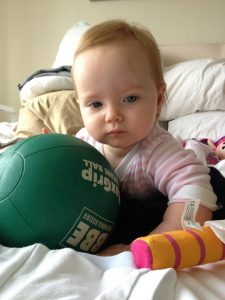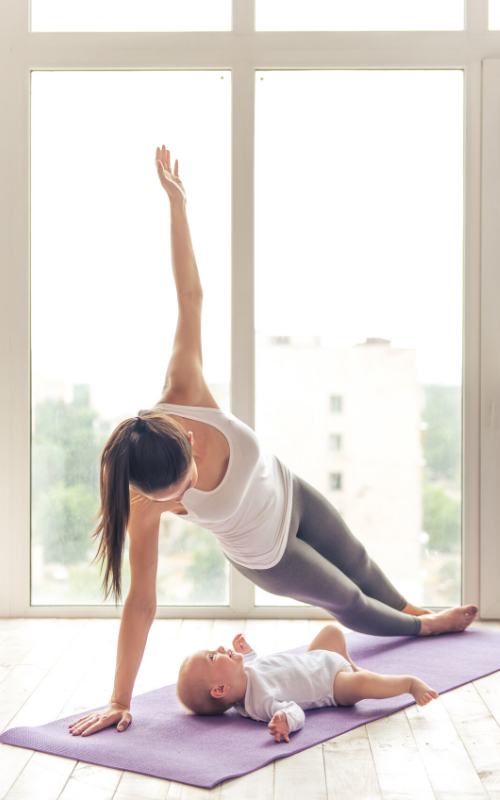Post Natal Training
Following an exercise programme in the post-natal period is so beneficial in terms of both physical and mental well-being. Working with a Hillcliff Personal Trainer will help ensure you're optimising your time and seeing the maximum benefits, while minimising the risks associated with the changes in your body.
Benefits


Although time demands on new mothers are extrememly high, finding time to fit exercise into your busy schdule will reap rewards:
improvements in posture
increases in stamina
higher energy levels
rise in metabolic rate facilitating weight loss
greater self confidence
reduced anxiety and stress levels
Factors to consider
When returning to fitness working with a personal trainer is so advantageous. It minimises the risk of injury and ensures your goals are realistic and achievable. The exercises will be safe and effective and tailored to the demands of your individual lifestyle and circumstances, and to the type of birth you experienced.

Postural correction
Throughout pregnancy the body’s centre of gravity gradually shifts as the foetus develops and grows in size. Any good post natal programme will include postural correction and maintenance. It's important to lengthen the muscles that may have become tight and to strengthen those that have been weakened during the second and third trimester.
Re-aligning abdominal muscles
During pregnancy the abdominal muscles separate along the linea alba (the line along the centre of your six pack) to make room for the baby causing what is known as diastasis recti abdominis. Three to four days after giving birth the muscles will begin to realign themselves. Depending on how strong the muscles were before pregnancy it can take up to six weeks or longer for full recovery. It’s important to incorporate gentle abdominal exercises to encourage the process of realignment. However, a number of abdominal exercises should be avoided altogether for some time after the birth as it can lead to further separation of the muscles resulting in a bulge in the abdominal wall causing a ‘doming’ effect. The process of realignment will then take far longer. In some cases the doming becomes permanent. Our post-natal experts are able to guide you through the correct progressions to improve strength in your abdominal musculature whilst avoiding these unnecessary complications.
Joint Stability
When pregnant the level of the hormone relaxin rises dramatically. The elasticity of cartilage and ligaments increases and causes joints to become unstable and more prone to injury. This is particularly true around the pelvic region but affects all joints. Relaxin will stay in the body post partum, and the amount of time it's present is entirely dependent on the individual. There are no hard and fast rules and every woman is different. Breast feeding is a key factor as this extends the length of time the hormone is present in inflated levels. In time ligaments return to their pre pregnancy states of elasticity, but if joints are stressed or over extended while relaxin is present in the body the damage may be irreversible. This can lead to hypermobility and permanent joint instability. Over stretching or high impact exercises will place unnecessary pressure on the joints. This is why it's important to follow a specific training programme which takes relaxin and it’s implications into account.
Pelvic floor
As with pre-natal training, maintaining strength in your pelvic floor is essential. The pressure exerted on this area by various types of training and even daily activities can lead to stress incontinence. It’s vital to keep up the kegels and other pelvic floor exercises during this time and long after the birth to maximise your ability to avoid this unfortunate reality of motherhood. Again, it’s important to consider the implications of high impact activities here as there is a risk of prolapse of the pelvic organs.
Breast Feeding
The timing of your exercise regime will affect the taste of your breast milk for your baby. Exercise increase's the amount of lactic acid present in the body. The best rule to follow to avoid this is to feed prior to exercise and at least one hour afterwards. This ensures the baby is receiving the best tasting and most nutrient rich milk.

If you’re interested in working with us through your post-natal period, contact us for further details or to book your consultation. The rewards of post natal exercise speak for themselves. Find out more about how we can help you following your new arrival with our tailored programmes designed by our specialists post-natal trainers.
Our clients say. . .
”I never had a personal trainer before but after having my baby boy I realised that I had complications which meant that it would not be possible to go to the gym as soon as I thought and do the same activities that I was used to, which was upsetting as I used to love going to my gym on a regular basis. Searching the web I came across Hillcliff’s website and after speaking to Claudine I was keen to get started as she was understanding to my needs. She is great, she listens to exactly what you want to get out of it and sets out a clear plan to help you achieve it. Each session is a thorough workout and never boring and I haven’t looked back. So pleased I found her! I not only feel physically great but have lost all of my postnatal weight and can fit into my pre-pregnancy jeans again AND its been lots of fun too! Would highly recommend them.”
P.Willock
"I trained with Claudine before getting pregnant, throughout the whole of my pregnancy, as soon as I could after having my baby. Our sessions were always tailored for my ever changing body. I really appreciated her expertise and company! Would highly recommend."
E.King
